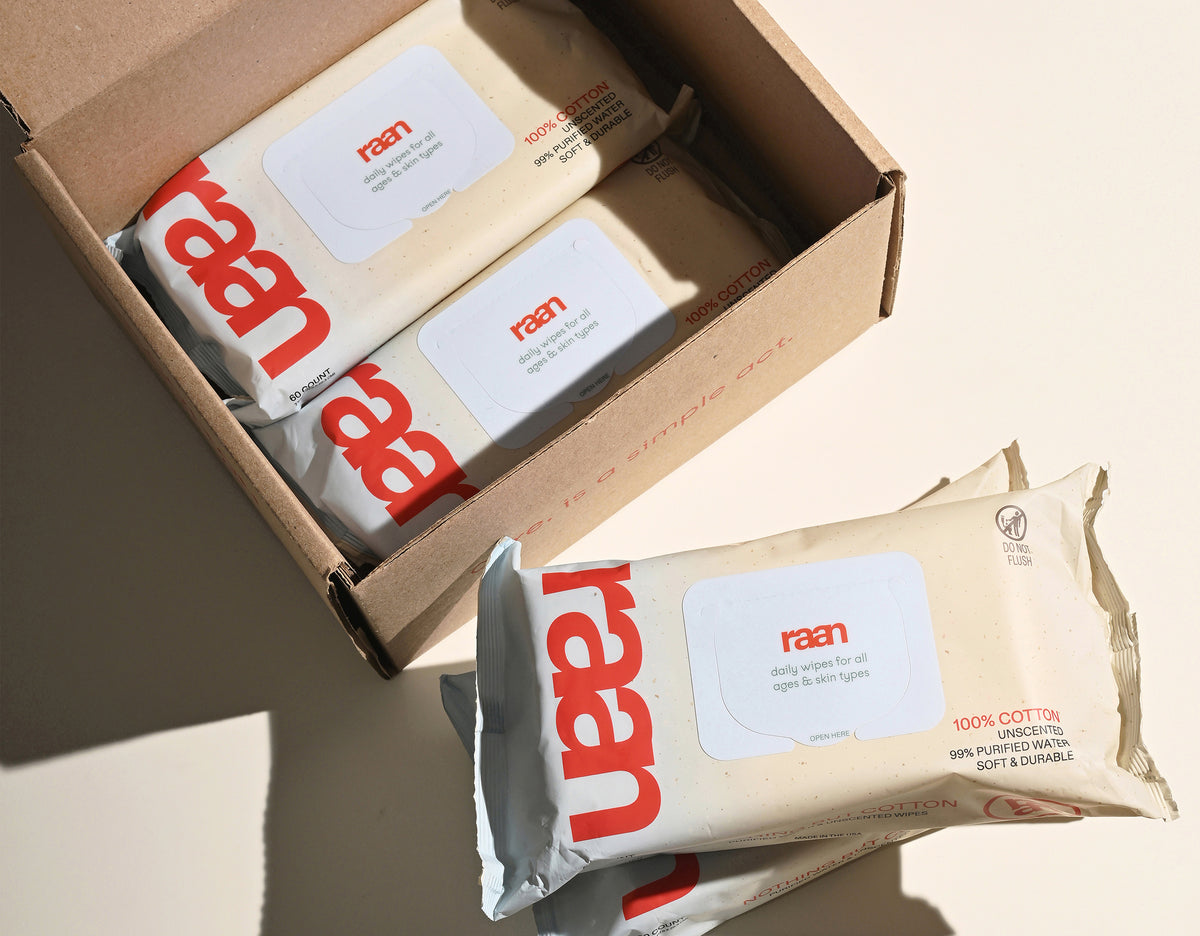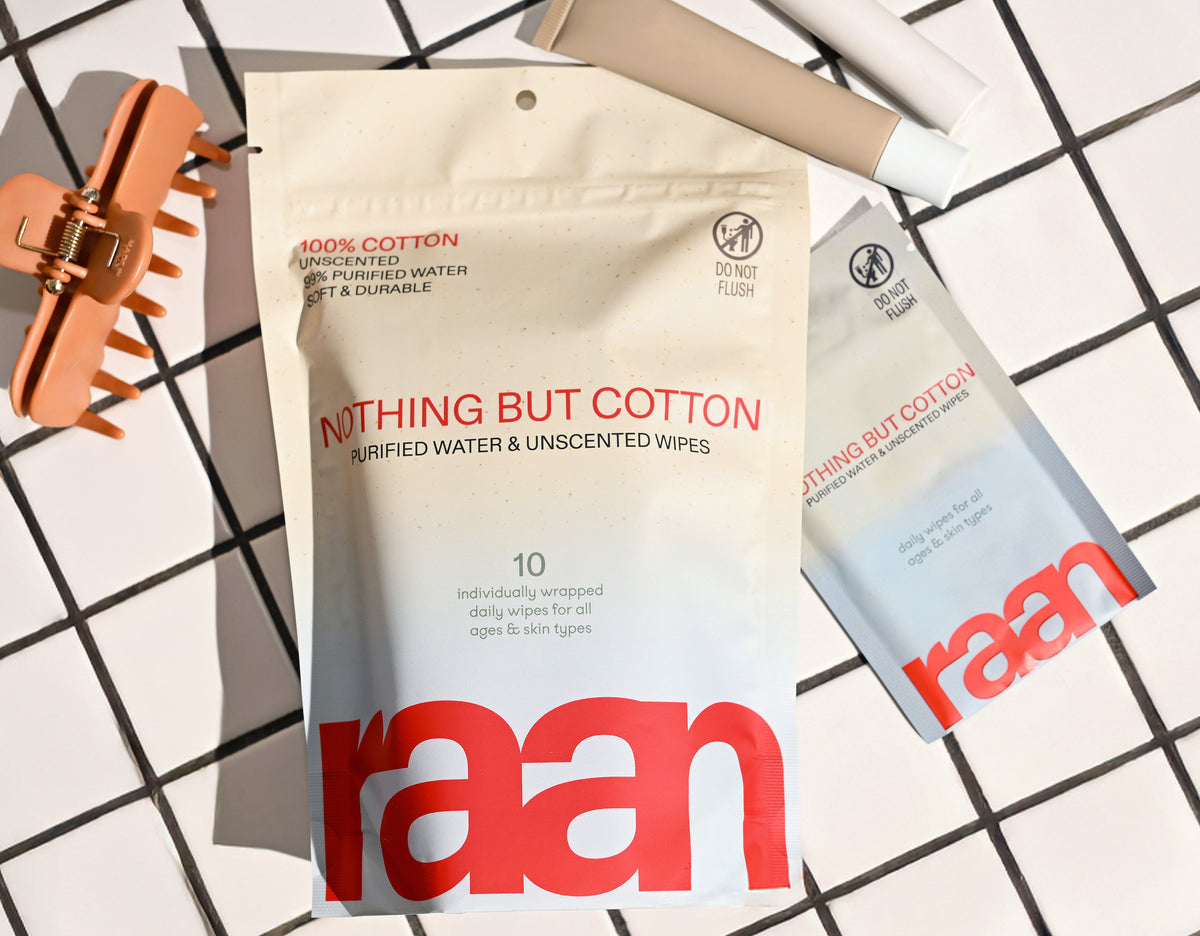Key Takeaways
- Finding genuinely safe baby wipes for sensitive skin is essential for newborns and toddlers with delicate skin.
- Many "hypoallergenic" labeled wipes may still cause irritation despite their claims.
- "99% water" wipes often contain synthetic preservatives and plastic fibers that can harm sensitive skin.
- Parents frequently learn through experience that not all gentle products are truly safe for sensitive skin.
Table of Contents
- What Are Baby Wipes for Sensitive Skin, And Why Do They Matter?
- Understanding Sensitive Skin, What Irritates, What Protects
- The Ingredients Checklist, What Matters (and What Doesn't)
- Baby Wipes for Sensitive Skin vs. Regular Wipes, A Science-Based Comparison
- Making Sense of Certifications & Trust Marks: What's Worth Your Attention
- Sustainable Choices, Do Eco-Friendly and Sensitive Go Hand-in-Hand?
- How to Choose Baby Wipes for Sensitive Skin, Expert Steps for Real Life
- Using Wipes Safely, For Newborns, Toddlers, and Everyday Messes
Baby Wipes for Sensitive Skin: An Honest Guide for Sensitive Families, Tiny and Tall
When your newborn's skin reacts to everything, or your toddler breaks out from seemingly "gentle" products, finding truly safe baby wipes for sensitive skin becomes urgent. Most parents discover the hard way that "hypoallergenic" labels don't guarantee safety, and "99% water" claims often hide synthetic preservatives and plastic fibers that irritate delicate skin. For a truly gentle solution, consider the only unbleached, 100% cotton baby wipe for sensitive skin.
Real sensitive-skin wipes require more than marketing promises, they need transparent ingredients, natural materials, and third-party verification. After years of navigating misleading "clean" claims, we've learned that genuinely safe wipes are rare, but they exist when you know what to look for. If you need a convenient option for on-the-go messes, try the unbleached, 100% cotton pocket wipe for sensitive skin.
For more guidance on choosing the right wipes, you can also explore this best baby wipes for sensitive skin resource.
What Are Baby Wipes for Sensitive Skin, And Why Do They Matter?
Sensitive skin baby wipes are specifically formulated for easily irritated, reactive skin using hypoallergenic ingredients and dermatologist-tested materials. Unlike regular wipes, they eliminate common triggers like synthetic fragrances, harsh preservatives, and plastic-blend fabrics that can cause micro-tears and inflammation.
Newborn skin is 20-30% thinner than adult skin, with an underdeveloped moisture barrier that makes it vulnerable to chemical irritants and rough textures. This delicate skin microbiome needs protection, not disruption from unnecessary additives or synthetic materials that can trigger eczema, diaper rash, or allergic contact dermatitis.
The difference lies in formulation philosophy: while conventional wipes prioritize shelf life and scent, baby wipes for sensitive skin prioritize skin barrier integrity and ingredient transparency. They use fewer, safer preservatives and natural materials that work with your baby's skin, not against it.
Understanding Sensitive Skin, What Irritates, What Protects

Sensitive skin reacts to specific triggers that healthy skin typically tolerates. Common culprits include synthetic fragrances, alcohol-based preservatives, phenoxyethanol, and plastic fibers that create microscopic abrasions during wiping.
pH imbalance is another major factor. Healthy skin maintains a slightly acidic pH of 4.5-6.5, but many wipes are formulated at higher pH levels that disrupt the skin's protective acid mantle. This disruption allows bacteria and irritants to penetrate deeper, causing inflammation and breakouts.
Protective ingredients work differently, they support skin function rather than simply avoiding harm. Organic aloe provides gentle moisture, while food-grade preservatives like sodium benzoate maintain safety without triggering reactions. The goal is active protection, not just passive avoidance of irritants.
The Ingredients Checklist, What Matters (and What Doesn't)
Effective sensitive skin wipes contain surprisingly few ingredients, typically five or fewer. The best formulas center on purified water (up to 99%), complemented by food-grade preservatives, natural moisturizers like organic aloe, and pH adjusters such as citric acid.
Food-grade preservatives matter because they're held to stricter safety standards than cosmetic-grade alternatives. Sodium benzoate and potassium sorbate, commonly used in baby food, provide necessary preservation without the sensitization risk of synthetic preservatives like phenoxyethanol or methylisothiazolinone.
| Ingredient Type | Raan's Choice | Common Alternatives | Why It Matters |
|---|---|---|---|
| Base | 99% Purified Water | Water + multiple solvents | Fewer ingredients = fewer reaction triggers |
| Preservative | Sodium Benzoate (food-grade) | Phenoxyethanol, Parabens | Food-grade standards prevent sensitization |
| Moisturizer | Organic Aloe | Glycerin, synthetic humectants | Natural moisture without pore-clogging |
| Material | Unbleached 100% Cotton | Plastic-blend nonwovens | No microplastics or fabric roughness |
EWG verification provides third-party confirmation that ingredients meet strict safety criteria for sensitive populations. This certification requires full ingredient disclosure and prohibits known sensitizers, offering parents real assurance beyond marketing claims.
Baby Wipes for Sensitive Skin vs. Regular Wipes, A Science-Based Comparison
The fundamental difference between sensitive skin and regular wipes lies in material science and formulation approach. Regular wipes prioritize durability and cost-effectiveness using plastic-blend fabrics and multi-functional preservatives, while sensitive formulas prioritize biocompatibility and gentleness.
Material composition creates the most significant impact. Plastic-blend nonwoven fabrics, used in most conventional wipes, can create microscopic tears in delicate skin and leave behind microplastic residues. Unbleached cotton, by contrast, provides natural absorbency without abrasion or synthetic residue.
Preservative systems also differ dramatically. Regular wipes often use broad-spectrum synthetic preservatives like phenoxyethanol or methylisothiazolinone that can sensitize skin over time. Baby wipes for sensitive skin rely on formulas that minimize these risks. For more information on gentle options, see our guide to soft wipes for newborn skincare.
Making Sense of Certifications & Trust Marks: What's Worth Your Attention

Certifications cut through marketing noise, but not all trust marks carry equal weight. For baby wipes for sensitive skin, focus on third-party verifications that test actual safety, not just slap feel-good labels on packaging.
The 4 Most Trustworthy Certifications for Sensitive Skin Wipes
- EWG Verified – Independent testing for ingredient safety and transparency
- Cruelty Free – No animal testing on ingredients or final products
- Natural Cotton Seal – Confirms 100% cotton fiber content without synthetic blends
- National Parenting Product Awards – Parent-tested functionality and safety validation
EWG Verified stands apart because it requires full ingredient disclosure and screens against thousands of concerning chemicals. Unlike vague "dermatologist tested" claims, EWG verification means independent scientists reviewed every component for safety.
Raan wipes carry EWG verification alongside cruelty-free and natural cotton certifications, backing up our five-ingredient formula with measurable standards. This combination addresses both ingredient safety and material integrity. If you want to try a variety of trusted options, check out the mess-ready pack for sensitive skin.
What certifications don't guarantee: "Natural" doesn't mean safe (poison ivy is natural). "Gentle" isn't regulated. "Pediatrician recommended" often lacks specific testing data. Look for numbered certifications and third-party verification over marketing language.
How to Spot Greenwashing: Genuine certifications include certification numbers, expiry dates, and specific testing standards. Vague phrases like "naturally inspired" or "plant-based formula" without backup documentation signal marketing over substance.
Sustainable Choices, Do Eco-Friendly and Sensitive Go Hand-in-Hand?
Earth-friendly and skin-friendly align more than you'd expect. Materials and processes that minimize environmental impact often reduce skin irritation too, fewer synthetic additives, less chemical processing, cleaner ingredient sourcing.
Unbleached cotton exemplifies this connection. Skipping the bleaching process eliminates chlorine residues that can trigger sensitive skin reactions while reducing environmental chemical runoff. The result: gentler wipes that biodegrade naturally.
| Material Type | Skin Impact | Environmental Impact | Breakdown Time |
|---|---|---|---|
| 100% Cotton (Unbleached) | Soft, breathable, minimal irritation | Biodegradable, renewable | 2-5 months |
| Plastic-Fiber Blend | Can cause microtears, traps moisture | Microplastic shedding | 100+ years |
| Bamboo Fiber | Naturally antimicrobial | Fast-growing, low water use | 4-6 months |
Microplastics from synthetic wipe materials don't just harm waterways, they can remain on skin surfaces and create microscopic irritation. Cotton fibers break down completely, leaving no residue on sensitive areas.
Raan's packaging reflects this same principle: 70% less plastic than standard wipes by eliminating hard plastic lids, plus 35% post-consumer waste content in pouches. Less plastic manufacturing means fewer chemical processes that could introduce irritating residues. For a complete starter bundle with eco-friendly packaging, explore the starter set.
For families managing eczema or recurring rashes, choosing biodegradable wipes often correlates with fewer flare-ups. The gentler processing required for sustainable materials typically results in purer, less reactive products. For more on eczema care in babies, see this resource from the American Academy of Dermatology.
How to Choose Baby Wipes for Sensitive Skin, Expert Steps for Real Life
Smart wipe selection starts with systematic label analysis, not package promises. Follow this evidence-based approach to identify truly safe options for reactive skin.
Sara's Safe-Start Steps
- Count ingredients – Under 10 total, with each ingredient clearly named
- Verify water content – Should be 95%+ for sensitive formulations
- Check preservative type – Food-grade preferred over synthetic alternatives
- Confirm material – 100% cotton or bamboo, avoid plastic blends
- Test before committing – Patch test on inner wrist for 24 hours
Reading ingredient lists effectively: Ingredients appear in descending order by concentration. If water isn't first, question the "99% water" claims. Look for specific preservative names (sodium benzoate, potassium sorbate) rather than vague "natural preservatives."
Red flags include numbered ingredients (like "Fragrance #47"), unlisted "proprietary blends," or more than 15 total components. Complex formulations increase reaction probability for sensitive skin types.
Patch testing protocol: Apply wipe to inner wrist or behind ear. Wait 24 hours, checking at 6, 12, and 24-hour marks for redness, swelling, or itching. Test during a period when no other new products are being introduced.
For newborns under 4 weeks, consult pediatricians before introducing any wipes. Their skin barrier isn't fully developed, making even gentle formulations potentially irritating. For additional tips, read our article on best wipes for delicate skin care.
Raan's five-ingredient transparency makes this process straightforward, purified water, two food-grade preservatives, organic aloe, and citric acid for pH balance. Each component serves a clear function without unnecessary additives.
Using Wipes Safely, For Newborns, Toddlers, and Everyday Messes

Proper technique prevents irritation as much as ingredient selection. Gentle application and appropriate frequency protect sensitive skin while maintaining effective cleaning.
Newborn guidelines (0-3 months): Use minimal pressure with patting motions rather than wiping. One wipe per diaper change typically suffices, overwiping disrupts delicate skin barriers. Focus cleaning on soiled areas only, avoiding unnecessary contact with unaffected skin.
Storage best practices: For safe diapering and hygiene routines, refer to these CDC diapering steps for best practices.
Frequently Asked Questions
What ingredients should I avoid in baby wipes to prevent irritation on sensitive skin?
Avoid synthetic preservatives, fragrances, plastic fibers, and bleach in baby wipes. These ingredients can cause irritation or micro-tears on delicate skin. Opt for wipes with minimal, food-grade preservatives and natural materials like unbleached, 100% cotton for better skin safety.
How do baby wipes for sensitive skin differ from regular baby wipes in terms of formulation and safety?
Baby wipes for sensitive skin use simpler, gentler ingredients and natural fibers to reduce irritation risks. Unlike regular wipes, they exclude synthetic fragrances, harsh preservatives, and plastic-based fabrics that can inflame or damage delicate skin, offering a safer, more transparent option.
Are 'hypoallergenic' and '99% water' labeled wipes always safe for newborns with sensitive skin?
Not always. Many wipes labeled 'hypoallergenic' or '99% water' still contain synthetic preservatives and plastic fibers that can irritate sensitive skin. True safety comes from transparent, minimal ingredients and natural materials, not just marketing claims.
What certifications or trust marks should I look for when choosing baby wipes for sensitive skin?
Look for EWG Verified, Natural Cotton Seal, Cruelty Free, and Women Owned certifications. These marks ensure ingredient transparency, safe materials, ethical practices, and trustworthy manufacturing standards for sensitive skin care.






